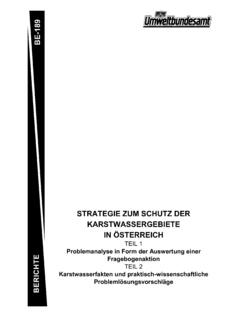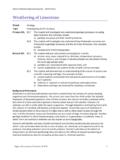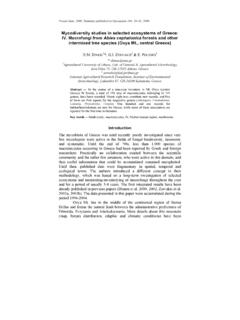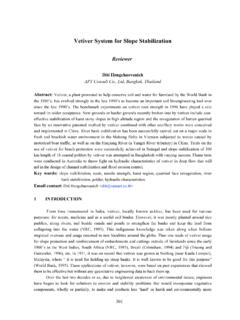Transcription of Uranium Pollution of Water Resources in Mined-Out and ...
1 Uranium Pollution OF Water Resources IN Mined-Out AND. ACTIVE GOLDFIELDS OF SOUTH AFRICA - A CASE STUDY IN THE WONDERFONTEINSPRUIT CATCHMENT ON. EXTENT AND SOURCES OF U-CONTAMINATION AND ASSOCIATED. HEALTH RISKS. FRANK WINDE. North-West University, School of Environmental Sciences and Development, Private Bag X6001, Potchefstroom, 2520, Republic of South Africa ABSTRACT. Even though mining-related Uranium Pollution in the Wonderfonteinspruit (WFS) has been an ongoing concern since the mid 1960s, media attention recently increased considerably focussing on Pollution -related health risks that unsettle the general public. In view of recent findings that Uranium (U) might be more toxic than previously thought such concerns need to be addressed.
2 This even more so as South Africa has embarked on a nuclear expansion program aimed, amongst others, at extending mining and processing of Uranium (U). This paper explores the impacts mining over the past decade had on U- Pollution of Water Resources in the WFS catchment. The analysis is mainly based on close to 3400, mostly unpublished, values on U-concentrations of Water samples gathered between 1997 and 2008. Results indicate that U-levels in Water Resources of the whole catchment increased markedly since 1997 even though U-loads emitted by some large gold mines in the Far West Rand were reduced. This apparent contradiction is explained by the contribution of highly polluted Water decanting from the flooded mine void in the West Rand.
3 Over the reference period, an average of some 3,5 t of dissolved U have been released into the fluvial system from monitored discharge points alone. However, since WFS dries up well before it joins the Mooi River this U-load does not usually impact on the Water supply system of downstream Potchefstroom directly. It may, however, indirectly reach Potchefstroom since much of the Water from the WFS recharges the underlying karst aquifer of the Boskop Turffontein Compartment (BTC). as the single most important Water resource for Potchefstroom. Compared to 1997 groundwater in the BTC showed the highest relative increase in U-levels of the whole WFS catchment resulting in some 800 kg of U per year flowing into Boskop Dam as Potchefstroom's main Water reservoir.
4 Of particular concern is the fact that U-levels in the WFS are comparable to those detected in the Northern Cape (South Africa) which had been geostatistically linked to abnormal haematological values related to increased incidences of leukaemia observed in residents of the area. Keywords: Uranium , Water Pollution , load, gold mining, karst, dolomite, health risks, Wonderfonteinspruit, West Rand, Far West Rand 1. INTRODUCTION: DEATH IN THE Water '. With the above headline on its front page the SOWETAN, in July 2007, drew the attention of its readership to the radioactive Water Pollution of the Wonderfonteinspruit (WFS). Together with well over 50 articles which appeared between 2007 and 2008 on this topic alone covering double, full and front pages of local and national newspapers, the article illustrates the degree of media attention Pollution of the WFS received.
5 The increased awareness on potential dangers associated with U in South Africa coincides with a globally renewed interest in Uranium as a climate-neutral source of energy fuelled by an ever widening gap between increasing demand and constant supply. Consequently, the U-spot price rose tenfold between 2003 and 2007 triggering large-scale exploration efforts to find new U-deposits in Africa and southern Africa in particular. During more than a century of gold mining in the catchment of the Wonderfonteinspruit (WFS) deep level gold mining brought more than 100000 t of U3O8 from depths of up to 3000 m, to the densely populated surface areas of the West Rand (WR) and Far West Rand (FWR) (Winde in press a and b).
6 Since 1952, U-producing gold mines in South Africa exported a total of some 240000 t of U more than double that amount (ca. 600000 t) is estimated to still be contained in gold mining tailings covering some 400 km in the Witwatersrand basin. These slimes dams and associated infrastructure such as return Water dams, pipelines, metallurgical plants etc. together with unmined uraniferous ore in mine voids constitute a multitude of sources from which U migrates, mostly uncontrolled, into the environment. In addition to wind and Water erosion of slimes dams transporting uraniferous tailings particles into adjacent areas, the chemical leaching of U from tailings particles and subsequent, waterborne transport as a dissolved phase into subjacent aquifers and nearby streams often constitutes the single largest source of mining-related Water Pollution .
7 In mined out areas such as the West Rand and Central Rand of the Witwatersrand basin Water flowing out of flooded mine voids may act as another major source of U- Pollution affecting surface- and groundwater. th rd Abstracts of the International Mine Water Conference 19 23 October 2009. Proceedings ISBN Number: 978-0-9802623-5-3 Pretoria, South Africa Produced by: Document Transformation Technologies cc Conference organised by: Cilla Taylor Conferences 772. With evidence mounting that the radioactive heavy metal U may pose a more severe health risk than previously thought even at comparably low concentrations, a thorough analyses of the extent of U- Pollution in the densely populated catchment of the WFS is needed.
8 This paper attempts to provide a comprehensive overview on available data in order to quantify the extent of U- Pollution in the WFS catchment and gain perspective for assessing possibly associated health risks. The focus is on the contamination of surface and groundwater as characterized by data from largely unpublished studies and includes first order approximations of associated U-loads in the WFS. The catchment of the WFS is shown in (Fig. 1). 27 E Sterkfontein 28 E. 27 30 (Cradle of Humankind) 26 S. WFS catchment border Twee Loopiespruit STEENKOPPIES. Krugersdorp West Rand r C2H152 West Wits Cons ive goldfield oi R. REGM Roodepoort HOLFONTEIN.
9 Mo Randfontein Bovenste Oog Kagiso C2H025. FS. REGM. Klerkskraal Oberh. eye Klerkskraal W. eyes Dam Venterspost C2H153. Harry's d. Padda d. am bed NUFCOR. dry stre Donaldson d Diamond VP eye ZUURBEKOM. C2H069 ne mine 1m - pipeli Westonaria Rand Water Khutsong VENTERS. Carleton- OBER- Bank eye POST pumping station ville HOLZER Western Area Welverdiend BANK Libanon GM N-shaft ACD. TD 1+2. VD1+2. Turffontein eyes Driefontein Kloof South Deep N. Doornfnt G. Mi Elandskraal Far West Rand goldfield 0 5 10km 26 30' S. nn ey ebro e n BOSKOP- Gold Mine (active and decommissioned). TURFFONTEIN Boskop Dam Karst spring (flowing/ dried up). Dam (not in proportion) (full/ dry).
10 Perennial/ non-perennial stream Wetland Potchefstroom C2H152 DWAF monitoring station (code no). Dam Discharge of mine effluents (via canal/ pipeline). Potchefstroom BTC Outcrop of full dolomitic compartment (NAME). BANK Outcrop of dewatered dolomitic compartments (NAME). Figure 1. The Study area (VD Visser dams, ACD Andries Coetzees dam, d. dam). A detailed description of the relevant hydrological and geohydrological features of the study area are provided in Winde (in press a and b). 2. U- Pollution OF STREAM Water IN THE WFS. Underlying data: The most extensive study on waterborne U- Pollution in the WFS catchment conducted to date is IWQS (1999) which is based on several hundreds of Water samples taken between January and December 1997 at 28.







